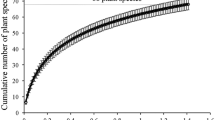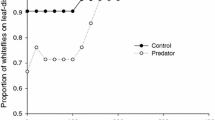Abstract
The feeding behavior of six chukar coveys was studied during September and October in a 20-ha sugar beet plantation located in an arid area in the northern Negev Desert of Israel. Coveys remained in separate areas of the field, and each covey inhabited repeatedly the same part of the field. Feeding on the sugar beet sprouts began soon after the start of germination, in the early morning and before sunset, each time for 1-2 hours. Analysis of the birds’ feeding behavior and the damage caused by them indicated most intensive feeding along the borders of areas containing sprouts, with a tendency to forage along the sowing rows; considerable locomotion while foraging; a preference for large sugar beet plants over small, germinating ones; and no difference in foraging according to the density of sprouts. The salinity of the water content in the germinating sprouts may have been, a factor in their being eaten.
Similar content being viewed by others
References
Alkon, P.U. (1974) Social behavior of a population of chukar partridge (Alectoris chukar Cypriotes) in Israel. Unpublished Ph.D. thesis, Cornell University, Ithaca, NY. Abstract in:Diss. Abstr. Int. (B) 34(12): 6268.
Alkon, P.U. (1979) Social behavior and a short-term population fluctuation in chukar partridge.Proc. 10th Scient. Conf. Israel Ecol. Soc., Sede Boqer. pp. 46–58.
Christensen, G.C. (1970) The Chukar Partridge.Biol. Bull. Nevada Dep. Fish Game 4.
Davis, N.B. (1974) The bird damage problem.Br. Sugar Beet Rev. 42: 19–22.
Dunning, R.A. (1974) Bird damage to sugar beet.Ann. appl. Biol. 76: 325–335.
Dunning, R.A. and Winder, G.H. (1972) Some effects, especially on yield, of artificially defoliating sugar beet.Ann. appl. Biol. 70: 89–98.
Inbar, R. (1975) [Birds of Israel]. Yavneh Publ., Tel Aviv. (in Hebrew)
Jones, F.G.W. (1957) Sugar Beet Pests. Bulletin 162. His Majesty’s Stationery Office, London.
Mendelssohn, H. (1971) Ecological effects of pest control programs on the fauna of Israel.Israel J.Zool. 20: 146–147.
Mendelssohn, H. (1972) The impact of pesticides on bird life in Israel.Bull. Int. Coun. Bird Present. 11: 75–104.
Mendelssohn, H. and Paz, U. (1977) The mortality of birds of prey caused by Azodrin, an organophosphorus insecticide.Biol. Conserv. 11: 163–170.
Nissani, R. (1974) [The geographic variability of the chukar partridge (Alectoris chukar) in Israel]. Unpublished M. Sc. thesis, The Hebrew University of Jerusalem, Israel. (in Hebrew)
Stokes, A.W. (1961) Voice and sexual behaviour of the chukar partridge.Condor 63: 111–127.
Stokes, A.W. (1963) Agonistic and sexual behaviour in the chukar partridge (Alectoris gracea).Anim. Behav. 11: 121–134.
Summers, D.D.B. and Jones, F.J.S. (1976) The importance of protein in the selection of fruit buds by bullfinches.Expl Hort. 28: 47–50.
Turner, E.R.A. (1964) Social feeding in birds.Behaviour 24: 1–46.
Watson, G.E. (1962) Sympatry in palaearctic partridges. Evolution 16: 11–19.
Author information
Authors and Affiliations
Rights and permissions
About this article
Cite this article
Benjamini, L. Feeding behavior of the chukar (Alectoris chukar) in sugar beet plantations. Phytoparasitica 8, 3–18 (1980). https://doi.org/10.1007/BF02986231
Received:
Issue Date:
DOI: https://doi.org/10.1007/BF02986231




